神经干细胞的培养鉴定及分化
- 格式:docx
- 大小:1.42 MB
- 文档页数:5
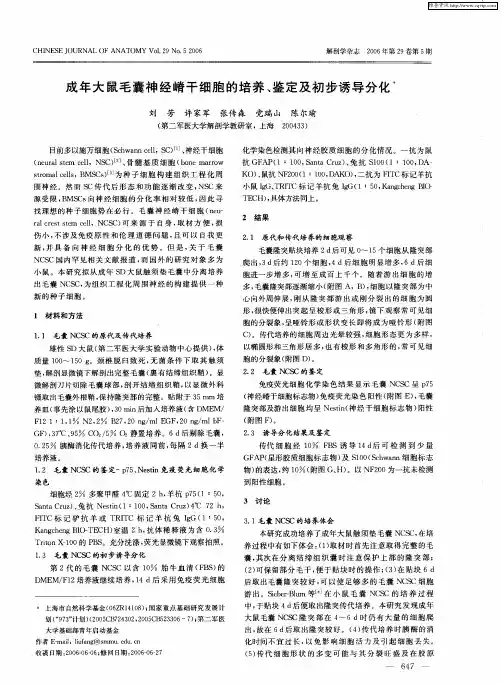
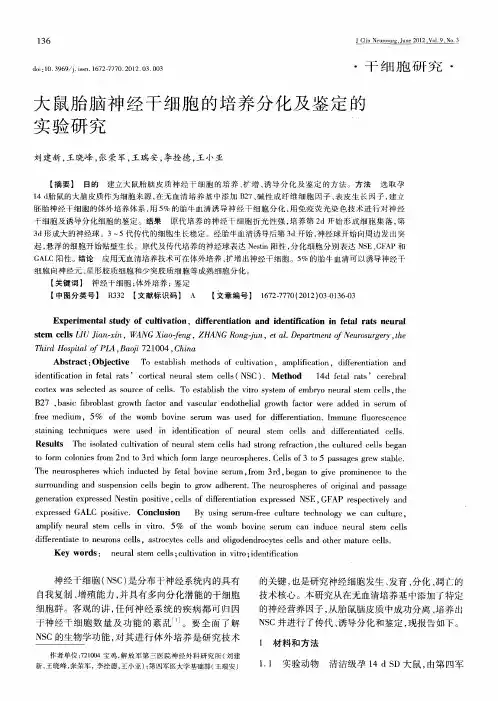
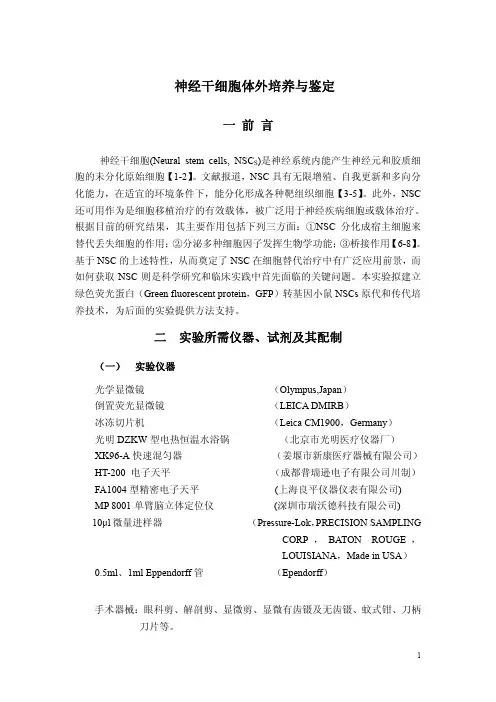
神经干细胞体外培养与鉴定一前言神经干细胞(Neural stem cells, NSC S)是神经系统内能产生神经元和胶质细胞的未分化原始细胞【1-2】。
文献报道,NSC具有无限增殖、自我更新和多向分化能力,在适宜的环境条件下,能分化形成各种靶组织细胞【3-5】。
此外,NSC 还可用作为是细胞移植治疗的有效载体,被广泛用于神经疾病细胞或载体治疗。
根据目前的研究结果,其主要作用包括下列三方面:①NSC分化成宿主细胞来替代丢失细胞的作用;②分泌多种细胞因子发挥生物学功能;③桥接作用【6-8】。
基于NSC的上述特性,从而奠定了NSC在细胞替代治疗中有广泛应用前景,而如何获取NSC则是科学研究和临床实践中首先面临的关键问题。
本实验拟建立绿色荧光蛋白(Green fluorescent protein,GFP)转基因小鼠NSCs原代和传代培养技术,为后面的实验提供方法支持。
二实验所需仪器、试剂及其配制(一)实验仪器光学显微镜(Olympus,Japan)倒置荧光显微镜(LEICA DMIRB)冰冻切片机(Leica CM1900,Germany)光明DZKW型电热恒温水浴锅(北京市光明医疗仪器厂)XK96-A快速混匀器(姜堰市新康医疗器械有限公司)HT-200 电子天平(成都普瑞逊电子有限公司川制)FA1004型精密电子天平(上海良平仪器仪表有限公司)MP 8001单臂脑立体定位仪(深圳市瑞沃德科技有限公司)10μl微量进样器(Pressure-Lok,PRECISION SAMPLINGCORP,BATON ROUGE,LOUISIANA,Made in USA)0.5ml、1ml Eppendorff管(Ependorff)手术器械:眼科剪、解剖剪、显微剪、显微有齿镊及无齿镊、蚊式钳、刀柄刀片等。
(二)试剂1. DMEM/F12,Hank's液(Hyclone),N2(Gibico),bFGF(Invitrogen)。
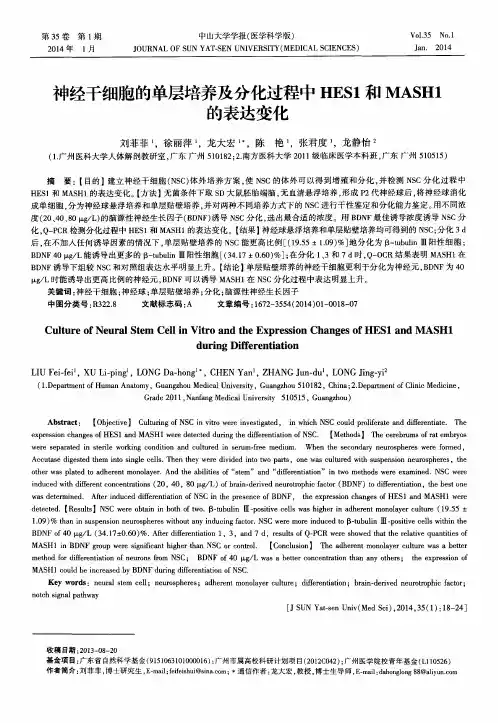
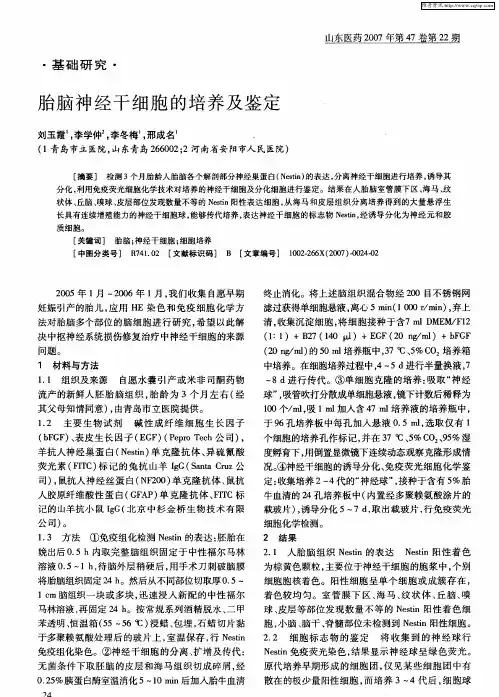
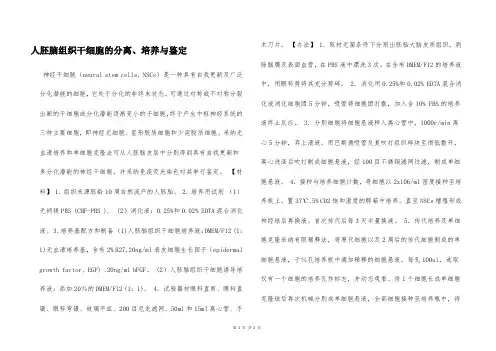
人胚脑组织干细胞的分离、培养与鉴定神经干细胞(neural stem cells, NSCs)是一种具有自我更新及广泛分化潜能的细胞,它处于分化的非终末状态,可通过对称或不对称分裂出新的干细胞或分化潜能逐渐变小的子细胞,终于产生中枢神经系统的三种主要细胞,即神经元细胞、星形胶质细胞和少突胶质细胞。
采纳无血清培养和单细胞克隆法可从人胚脑皮层中分别得到具有自我更新和多分化潜能的神经干细胞,并采纳免疫荧光染色对其举行鉴定。
【材料】 1.组织来源胚龄10周自然流产的人胚胎。
2.培养用试剂(1)无钙镁PBS (CMF-PBS )。
(2)消化液:0.25%和0.02% EDTA混合消化液。
3.培养基配方和制备(1)人胚脑组织干细胞培养液:DMEM/F12 (1:1)无血清培养基,含有2% B27,20ng/ml表皮细胞生长因子(epidermalgrowth factor, EGF) ,20ng/ml bFGF。
(2)人胚脑组织干细胞诱导培养液:添加20%的DMEM/Fl2 (1:1)。
4.试验器材眼科直剪、眼科直镊、眼科弯镊、玻璃平皿、200目尼龙滤网、50ml和15ml离心管、手术刀片。
【办法】 1.取材无菌条件下分别出胚胎大脑皮质组织,剥除脑膜及表面血管,在PBS液中漂洗3次。
在含有DMEM/F12的培养液中,用眼科剪将其充分剪碎。
2.消化用0.25%和0.02% EDTA混合消化液消化细胞团5分钟,吸管将细胞团打散,加入含10% FBS的培养液终止反应。
3.分别细胞将细胞悬液移入离心管中,1000r/min离心5分钟,弃上清液。
用巴斯德吸管反复吹打组织碎块至彻低散开,离心洗涤后吹打制成细胞悬液,经100目不锈钢滤网过滤,制成单细胞悬液。
4.接种与培养细胞计数,将细胞以2x106/ml密度接种至培养板上。
置37℃,5% C02饱和湿度的孵箱中培养。
直至NSCs增殖形成神经球后再换液。
首次传代后每3天半量换液。
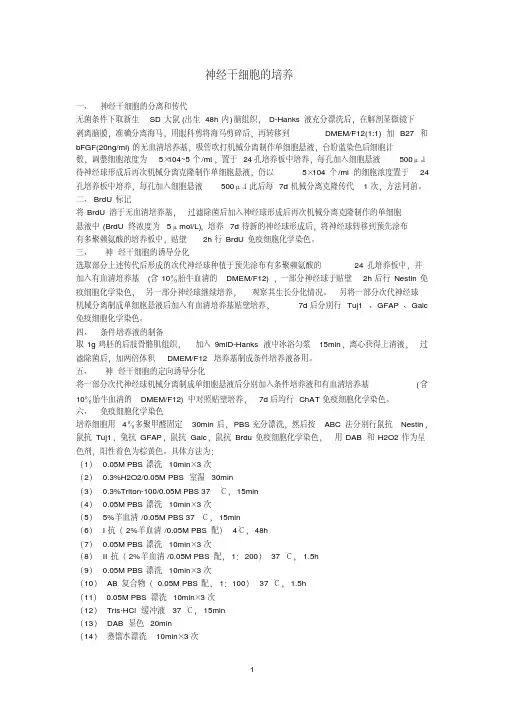
神经干细胞的培养一、神经干细胞的分离和传代无菌条件下取新生SD大鼠(出生48h内)脑组织,D-Hanks液充分漂洗后,在解剖显微镜下剥离脑膜,准确分离海马,用眼科剪将海马剪碎后,再转移到DMEM/F12(1:1)加B27 和bFGF(20ng/ml)的无血清培养基,吸管吹打机械分离制作单细胞悬液,台盼蓝染色后细胞计数,调整细胞浓度为5×104~5个/ml,置于24孔培养板中培养,每孔加入细胞悬液500μl。
待神经球形成后再次机械分离克隆制作单细胞悬液,仍以5×104个/ml的细胞浓度置于24孔培养板中培养,每孔加入细胞悬液500μl。
此后每7d机械分离克隆传代1次,方法同前。
二、BrdU标记将BrdU溶于无血清培养基,过滤除菌后加入神经球形成后再次机械分离克隆制作的单细胞悬液中(BrdU终浓度为5μmol/L),培养7d待新的神经球形成后,将神经球转移到预先涂布有多聚赖氨酸的培养板中,贴壁2h行BrdU免疫细胞化学染色。
三、神经干细胞的诱导分化选取部分上述传代后形成的次代神经球种植于预先涂布有多聚赖氨酸的24孔培养板中,并加入有血清培养基(含10%胎牛血清的DMEM/F12),一部分神经球于贴壁2h后行Nestin免疫细胞化学染色,另一部分神经球继续培养,观察其生长分化情况。
另将一部分次代神经球机械分离制成单细胞悬液后加入有血清培养基贴壁培养,7d后分别行Tuj1 、GFAP 、Galc 免疫细胞化学染色。
四、条件培养液的制备取1g鸡胚的后肢骨骼肌组织,加入9mlD-Hanks液中冰浴匀浆15min,离心获得上清液,过滤除菌后,加两倍体积DMEM/F12培养基制成条件培养液备用。
五、神经干细胞的定向诱导分化将一部分次代神经球机械分离制成单细胞悬液后分别加入条件培养液和有血清培养基(含10%胎牛血清的DMEM/F12)中对照贴壁培养,7d后均行ChAT免疫细胞化学染色。
六、免疫细胞化学染色培养细胞用4%多聚甲醛固定30min后,PBS充分漂洗,然后按ABC法分别行鼠抗Nestin,鼠抗Tuj1,兔抗GFAP,鼠抗Galc,鼠抗Brdu免疫细胞化学染色,用DAB和H2O2作为呈色剂,阳性着色为棕黄色。
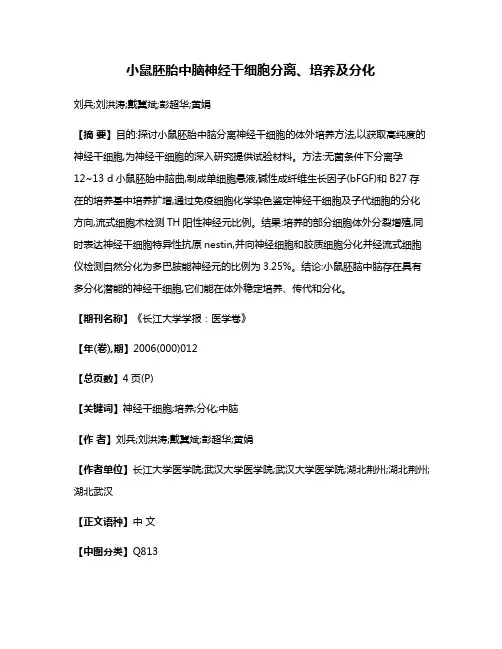
小鼠胚胎中脑神经干细胞分离、培养及分化刘兵;刘洪涛;戴冀斌;彭超华;黄娟【摘要】目的:探讨小鼠胚胎中脑分离神经干细胞的体外培养方法,以获取高纯度的神经干细胞,为神经干细胞的深入研究提供试验材料。
方法:无菌条件下分离孕12~13 d小鼠胚胎中脑曲,制成单细胞悬液,碱性成纤维生长因子(bFGF)和B27存在的培养基中培养扩增,通过免疫细胞化学染色鉴定神经干细胞及子代细胞的分化方向,流式细胞术检测TH阳性神经元比例。
结果:培养的部分细胞体外分裂增殖,同时表达神经干细胞特异性抗原nestin,并向神经细胞和胶质细胞分化并经流式细胞仪检测自然分化为多巴胺能神经元的比例为3.25%。
结论:小鼠胚脑中脑存在具有多分化潜能的神经干细胞,它们能在体外稳定培养、传代和分化。
【期刊名称】《长江大学学报:医学卷》【年(卷),期】2006(000)012【总页数】4页(P)【关键词】神经干细胞;培养;分化;中脑【作者】刘兵;刘洪涛;戴冀斌;彭超华;黄娟【作者单位】长江大学医学院;武汉大学医学院;武汉大学医学院;湖北荆州;湖北荆州;湖北武汉【正文语种】中文【中图分类】Q813神经干细胞(neural stem cells, NSCs)是一类广泛存在于胚胎及成体中枢神经系统的早期未分化细胞,被认为是神经系统的“发源地”[1]。
应用神经干细胞移植的方法修复神经系统脑的损伤与治疗人类神经退行性疾病中更显示出其优越性,其中最具有代表性的就是怕金森病,然而,这种方法在患者中广泛应用的障碍就是胚脑移植的问题。
本试验对小鼠胚胎中脑神经干细胞的分离和培养进行了尝试,为神经干细胞的进一步研究奠定基础。
1 材料与方法1.1 材料1) 实验动物孕12~13 d昆明小鼠(E12~13 d,SPF级),由武汉大学医学院实验动物中心提供。
2) 试剂 DMEM/F12培养基,特优级胎牛血清(FBS),B27均购自GIBCO公司;碱性成纤维生长因子(bFGF)购自Peprotech公司;胰酶(Trypsin)、DNA酶1(DNase1)、左旋多聚赖氨酸(PLL)和DAPI购自SIGMA公司。
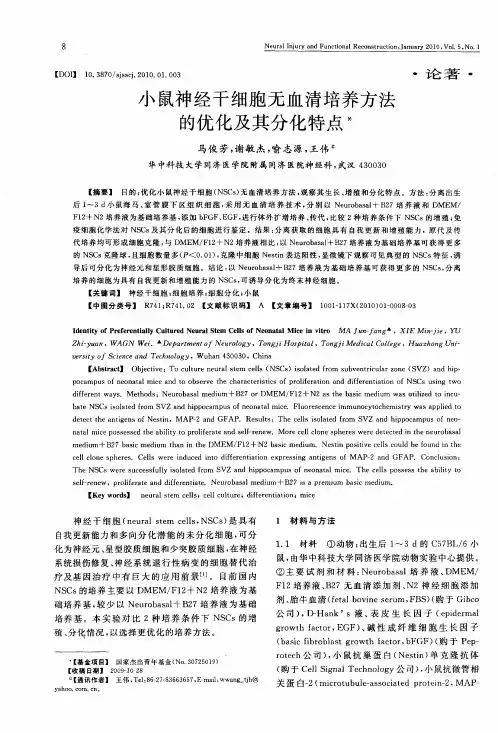
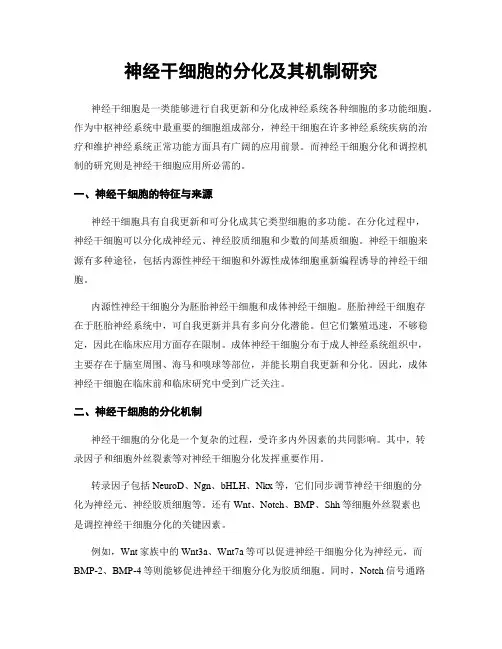
神经干细胞的分化及其机制研究神经干细胞是一类能够进行自我更新和分化成神经系统各种细胞的多功能细胞。
作为中枢神经系统中最重要的细胞组成部分,神经干细胞在许多神经系统疾病的治疗和维护神经系统正常功能方面具有广阔的应用前景。
而神经干细胞分化和调控机制的研究则是神经干细胞应用所必需的。
一、神经干细胞的特征与来源神经干细胞具有自我更新和可分化成其它类型细胞的多功能。
在分化过程中,神经干细胞可以分化成神经元、神经胶质细胞和少数的间基质细胞。
神经干细胞来源有多种途径,包括内源性神经干细胞和外源性成体细胞重新编程诱导的神经干细胞。
内源性神经干细胞分为胚胎神经干细胞和成体神经干细胞。
胚胎神经干细胞存在于胚胎神经系统中,可自我更新并具有多向分化潜能。
但它们繁殖迅速,不够稳定,因此在临床应用方面存在限制。
成体神经干细胞分布于成人神经系统组织中,主要存在于脑室周围、海马和嗅球等部位,并能长期自我更新和分化。
因此,成体神经干细胞在临床前和临床研究中受到广泛关注。
二、神经干细胞的分化机制神经干细胞的分化是一个复杂的过程,受许多内外因素的共同影响。
其中,转录因子和细胞外丝裂素等对神经干细胞分化发挥重要作用。
转录因子包括NeuroD、Ngn、bHLH、Nkx等,它们同步调节神经干细胞的分化为神经元、神经胶质细胞等。
还有Wnt、Notch、BMP、Shh等细胞外丝裂素也是调控神经干细胞分化的关键因素。
例如,Wnt家族中的Wnt3a、Wnt7a等可以促进神经干细胞分化为神经元,而BMP-2、BMP-4等则能够促进神经干细胞分化为胶质细胞。
同时,Notch信号通路在神经系统发育中起重要作用。
在神经干细胞分化为神经元时,Ngn蛋白通过调节Notch信号的激活,有助于促进神经元的分化。
除此之外,环境因素如细胞外基质、细胞因子等也都可以影响神经干细胞的分化。
环境因素对神经干细胞分化具有重要的生理学意义,在神经干细胞的体内体外放大和应用过程中也需要考虑环境因素的影响。
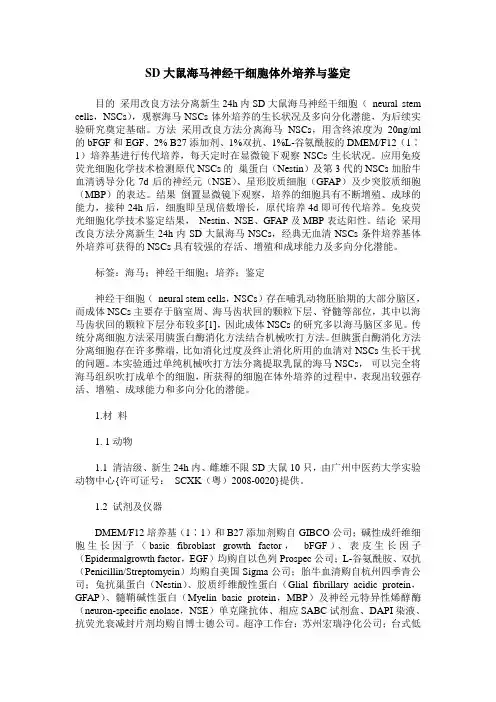
SD大鼠海马神经干细胞体外培养与鉴定目的采用改良方法分离新生24h内SD大鼠海马神经干细胞(neural stem cells,NSCs),观察海马NSCs体外培养的生长状况及多向分化潜能,为后续实验研究奠定基础。
方法采用改良方法分离海马NSCs,用含终浓度为20ng/ml 的bFGF和EGF、2% B27添加剂、1%双抗、1%L-谷氨酰胺的DMEM/F12(1∶1)培养基进行传代培养,每天定时在显微镜下观察NSCs生长状况。
应用免疫荧光细胞化学技术检测原代NSCs的巢蛋白(Nestin)及第3代的NSCs加胎牛血清诱导分化7d后的神经元(NSE)、星形胶质细胞(GFAP)及少突胶质细胞(MBP)的表达。
结果倒置显微镜下观察,培养的细胞具有不断增殖、成球的能力,接种24h后,细胞即呈现倍数增长,原代培养4d即可传代培养。
免疫荧光细胞化学技术鉴定结果,Nestin、NSE、GFAP及MBP表达阳性。
结论采用改良方法分离新生24h内SD大鼠海马NSCs,经典无血清NSCs条件培养基体外培养可获得的NSCs具有较强的存活、增殖和成球能力及多向分化潜能。
标签:海马;神经干细胞;培养;鉴定神经干细胞(neural stem cells,NSCs)存在哺乳动物胚胎期的大部分脑区,而成体NSCs主要存于脑室周、海马齿状回的颗粒下层、脊髓等部位,其中以海马齿状回的颗粒下层分布较多[1],因此成体NSCs的研究多以海马脑区多见。
传统分离细胞方法采用胰蛋白酶消化方法结合机械吹打方法。
但胰蛋白酶消化方法分离细胞存在许多弊端,比如消化过度及终止消化所用的血清对NSCs生长干扰的问题。
本实验通过单纯机械吹打方法分离提取乳鼠的海马NSCs,可以完全将海马组织吹打成单个的细胞,所获得的细胞在体外培养的过程中,表现出较强存活、增殖、成球能力和多向分化的潜能。
1.材料1. 1动物1.1 清洁级、新生24h内、雌雄不限SD大鼠10只,由广州中医药大学实验动物中心{许可证号:SCXK(粤)2008-0020}提供。
神经干细胞综述长期以来 ,人们一直认为 ,成年哺乳动物脑内神经细胞不具备更新能力 ,一旦受损乃至死亡 ,不能再生 ,这种观点使人们对帕金森病、多发性硬化及脑脊髓损伤的治疗受到了很大的限制。
虽然传统的药物及手术取得了一定的进展 ,但是仍不能达到满意的效果。
近年来 ,生物医学技术迅猛发展 ,神经生物学的重要进展之一是发现神经干细胞的存在 ,特别是成体脑内神经干细胞的分离和鉴定具有划时代意义。
本文对神经干细胞的特点、分布、分化机制及应用等研究进展做一综述。
1 神经干细胞的特点神经干细胞的特点如下:①神经干细胞可以分化。
②通过分裂产生相同的神经干细胞来维持自身的存在 ,同时 ,也能产生子细胞并进一步分化成各种成熟细胞。
干细胞可连续分裂几代 ,也可在较长时间内处于静止状态。
③神经干细胞通过两种方式生长 ,一种是对称分裂 ,形成两个相同的神经干细胞 ;另一种是非对称分裂 ,由于细胞质中的调节分化蛋白不均匀的分配 ,使得一个子细胞不可逆的走向分化的终端而成为功能专一的分化细胞 ,另一个子细胞则保持亲代的特征 ,仍作为神经干细胞保留下来。
分化细胞的数目受分化前干细胞的数目和分裂次数控制。
2 神经干细胞与其它类型干细胞的关系按分化潜能的大小 ,干细胞基本上可分为 3种类型 :第一类是全能干细胞 ,它具有形成完整个体的分化潜能 ,具有与早期胚胎细胞相似的形态特征和很强的分化能力 ,可以无限增殖并分化成全身 2 0 0多种细胞组织的潜能 ,进一步形成机体的所有组织、器官进而形成个体 ;第二类是多能干细胞 ,这种干细胞也具有分化多种细胞组织的潜能 ,但却失去了发育成完整个体的能力 ,发育潜能受到一定的限制 ;第三类是单能干细胞 ,如神经干细胞等 ,这种细胞只能向一种类型或密切相关的两种类型的细胞分化。
然而横向分化的发现 ,使这个观点受到了挑战 ,神经干细胞可以分化成造血细胞。
总之 ,生命体通过干细胞的分裂来实现细胞的更新及保证持续生长。
神经干细胞的分化与发育神经干细胞是一种未分化的神经细胞,具有自我更新和分化为多种神经细胞的能力。
它们在神经系统的发育和修复过程中起着重要的作用。
神经干细胞的分化与发育过程十分复杂,涉及到多种信号通路和调节因子的作用。
神经干细胞的分化过程可以分为几个阶段。
首先,神经干细胞开始向神经前体细胞分化,这时它们逐渐失去自我更新的能力。
接着,神经前体细胞会进一步分化成神经元和神经胶质细胞,这些细胞在神经系统的结构和功能中都发挥着重要的作用。
神经干细胞的分化和发育过程是受多种信号通路和调节因子的影响的。
其中,Notch信号通路是一个非常重要的调节因子。
Notch信号通路通过Notch受体和其配体相互作用,调节神经干细胞的分化和细胞命运。
另外,Wnt信号通路、BMP信号通路、NGF信号通路等也都具有重要的调节作用。
在神经干细胞发育和分化过程中,还存在着许多基因的参与。
例如,Ngn1、Mash1等转录因子和NeuroD等神经发育因子都是参与神经干细胞分化和发育的重要基因。
这些基因通过直接或间接地调节神经干细胞的基因表达,从而影响它们的分化和命运。
除了信号通路和基因的调节外,还有其他因素也影响着神经干细胞的发育和分化。
例如,细胞外基质、微环境等因素都可以影响神经干细胞的细胞命运和分化方向。
因此,在研究神经干细胞发育和分化过程中,需要充分考虑这些因素的综合作用。
最近的研究表明,神经干细胞的分化和发育过程可能存在着时序性的调节。
这意味着,在不同的发育时期,神经干细胞对不同的信号通路和调节因子的响应不同。
例如,在产生神经元的初期,Wnt和BMP信号通路对神经干细胞的分化起着重要的作用,但在后期,这些信号通路的影响可能更小。
总之,神经干细胞的分化和发育过程是一个复杂而精细的过程,涉及到多个信号通路和调节因子的综合作用。
这些知识可以为神经系统的发育和修复提供重要的理论依据,也为相关疾病的治疗提供了新思路。
神经干细胞的培养一、神经干细胞的分离和传代无菌条件下取新生SD大鼠(出生48h内)脑组织,D-Hanks液充分漂洗后,在解剖显微镜下剥离脑膜,准确分离海马,用眼科剪将海马剪碎后,再转移到DMEM/F12(1:1)加B27 和bFGF(20ng/ml)的无血清培养基,吸管吹打机械分离制作单细胞悬液,台盼蓝染色后细胞计数,调整细胞浓度为5×104~5个/ml,置于24孔培养板中培养,每孔加入细胞悬液500μl。
待神经球形成后再次机械分离克隆制作单细胞悬液,仍以5×104个/ml的细胞浓度置于24孔培养板中培养,每孔加入细胞悬液500μl。
此后每7d机械分离克隆传代1次,方法同前。
二、BrdU标记将BrdU溶于无血清培养基,过滤除菌后加入神经球形成后再次机械分离克隆制作的单细胞悬液中(BrdU终浓度为5μmol/L),培养7d待新的神经球形成后,将神经球转移到预先涂布有多聚赖氨酸的培养板中,贴壁2h行BrdU免疫细胞化学染色。
三、神经干细胞的诱导分化选取部分上述传代后形成的次代神经球种植于预先涂布有多聚赖氨酸的24孔培养板中,并加入有血清培养基(含10%胎牛血清的DMEM/F12),一部分神经球于贴壁2h后行Nestin免疫细胞化学染色,另一部分神经球继续培养,观察其生长分化情况。
另将一部分次代神经球机械分离制成单细胞悬液后加入有血清培养基贴壁培养,7d后分别行Tuj1 、GFAP 、Galc 免疫细胞化学染色。
四、条件培养液的制备取1g鸡胚的后肢骨骼肌组织,加入9mlD-Hanks液中冰浴匀浆15min,离心获得上清液,过滤除菌后,加两倍体积DMEM/F12培养基制成条件培养液备用。
五、神经干细胞的定向诱导分化将一部分次代神经球机械分离制成单细胞悬液后分别加入条件培养液和有血清培养基(含10%胎牛血清的DMEM/F12)中对照贴壁培养,7d后均行ChA T免疫细胞化学染色。
六、免疫细胞化学染色培养细胞用4%多聚甲醛固定30min后,PBS充分漂洗,然后按ABC法分别行鼠抗Nestin,鼠抗Tuj1,兔抗GFAP,鼠抗Galc,鼠抗Brdu免疫细胞化学染色,用DAB和H2O2作为呈色剂,阳性着色为棕黄色。
神经干细胞的增殖与分化调控机制研究神经干细胞是具有自我复制和分化潜能的干细胞,可以分化为多种神经元和神经胶质细胞。
神经干细胞的增殖和分化调控是神经发育和再生的基础,对于神经系统相关的疾病的治疗和康复具有重要意义。
本文将介绍神经干细胞增殖和分化的调控机制,包括细胞内信号通路、外环境因素以及表观遗传学等方面的研究进展。
一、细胞内信号通路神经干细胞增殖和分化的调控主要是由一系列复杂的信号通路调节的。
其中,Wnt、Notch和Hedgehog等信号通路起着重要的作用。
Wnt信号通路是最为熟知的神经干细胞生长因子之一,对神经干细胞的增殖和分化都具有调节作用。
Wnt信号的激活可以导致β-catenin的稳定和聚集,从而激活与之相关的基因,包括c-myc、cyclin D1等。
同时,Wnt信号还可以通过Axin-LRP5/6-Fz复合物的形成促进神经干细胞的自我更新。
Notch信号通路也是调节神经干细胞生长和分化的重要信号通路之一,通过Notch与Delta或Jagged等配体的结合,激活Notch受体并抑制神经干细胞向神经元的分化,同时促进胶质细胞的分化。
Hedgehog信号通路是最近发现的重要的神经干细胞增殖和分化调控因子,具有复杂的信号调节机制。
Hedgehog信号通路与Ptc、Smo、Gli等分子相互作用,调节神经干细胞的增殖和分化。
目前Hedgehog信号通路在神经系统肿瘤的治疗方面已经得到了广泛的应用。
二、外环境因素神经干细胞增殖和分化的调控不仅受到内部信号通路的调节,还受到外部环境因素的影响。
细胞外基质、化学物质、神经因子等因素都是影响神经干细胞增殖和分化的重要因素。
细胞外基质的组成和刚度对于神经干细胞增殖和分化的影响已经成为了一个新兴的研究领域。
细胞条件培养下,刚度为1-100kPa的基质可以促进神经干细胞向神经元的分化;而刚度为1-10kPa的基质则可以促进神经干细胞向胶质细胞的分化。
此外,细胞外基质中的天然物质如胶原蛋白、Laminin等可以通过与细胞表面分子相互作用来调节神经干细胞增殖和分化。
干细胞的培养和分化研究干细胞是一种具有自我更新和分化为多种细胞类型潜能的细胞。
它们是医学和生物技术领域中备受关注的一种细胞类型,其在组织修复和再生、疾病治疗等方面具有潜在应用价值。
而干细胞的培养和分化研究,则是实现这一潜在应用价值的重要前提。
一、干细胞的培养干细胞的培养是指将干细胞体外培养至一定数量和状态的过程。
这个过程对于干细胞研究和应用来说是至关重要的。
目前,干细胞的培养方法主要包括以下几种。
1. 传统培养法传统培养法是指将干细胞放置在含有适宜营养物质的培养液中,促进其增殖和生长。
这种方法简单易懂,适用于许多种干细胞(如造血干细胞、神经干细胞、胚胎干细胞等)的培养。
它的缺点是,培养液中含有的营养物质无法完全满足干细胞生长的需要,使得其增殖和分化存在一定的限制。
2. 三维培养法三维培养法是指将干细胞种植在一种支架材料或胶体中,形成三维空间结构,促进干细胞的增殖和分化。
这种方法可以模拟体内环境,并提供更多的生长空间,有利于干细胞的生长和分化。
但是其操作比较复杂,需要大量的支架材料和胶体,而且其空间结构可能会影响干细胞的增殖和分化。
3. 其他培养法除了传统培养法和三维培养法外,还有许多其他的培养方法,如基质培养法、表面培养法、微载体培养法等。
这些方法都有其独特的优点和缺点,可以根据不同的需求和应用选择适宜的培养方法。
二、干细胞的分化干细胞的分化是指将其分化为不同类型的成熟细胞,如神经元、心肌细胞、肌肉细胞等。
干细胞的分化是干细胞研究和应用的最终目标,也是最具挑战性的问题之一。
1. 诱导分化法诱导分化法是指通过特定的诱导因子和培养条件,促进干细胞向特定的细胞类型分化。
例如,在干细胞培养液中加入特定的生长因子和培养条件,可以促进胚胎干细胞向神经元、心肌细胞等方向分化。
这种方法非常具有前景,可以实现干细胞的精准分化。
但是其操作比较复杂,需要精细的控制和紧密的监测。
2. 基因编辑法基因编辑法是指通过基因编辑技术(如CRISPR/Cas9技术),改变干细胞的基因编码序列,促进干细胞向特定的细胞类型分化。
干细胞的定向分化和功能培养干细胞是一类能够无限分裂并能够分化成各种细胞类型的细胞,被广泛应用于生物医学领域。
其中,干细胞的定向分化和功能培养技术被认为是实现组织工程和再生医学的重要途径。
一、干细胞的定向分化技术定向分化是指通过特定的信号模拟体内环境来促使干细胞向特定的细胞类型分化,从而实现组织修复和再生的目的。
定向分化技术主要包括两种:一是内源性定向分化,通过体外培养环境和细胞因子等方式刺激干细胞向特定的细胞类型分化;二是外源性定向分化,通过重编程技术改变细胞命运决定基因的表达,从而实现分化成特定细胞类型的目的。
内源性定向分化技术在干细胞的功能培养和组织修复领域得到了广泛的应用。
例如,肌肉干细胞可以通过在细胞培养环境中加入肌肉细胞因子和信号来促进其分化成肌肉细胞,用于治疗肌肉萎缩和肌肉缺失等疾病。
另外,胰岛素细胞可以通过内源性定向分化技术从干细胞中分化出来,用于治疗糖尿病。
外源性定向分化技术是目前热门的干细胞定向分化技术之一。
该技术主要利用转录因子、类似因子和代表性蛋白等无限制性物质重编程的原理,通过在培养环境中加入特定的成分,达到在干细胞中诱导特定的基因表达,从而实现外源性定向分化。
二、干细胞的功能培养技术功能培养是指利用体外培养环境和信号,激发干细胞的分化能力,使其分化成具有特定功能的细胞,从而实现多种组织和器官的修复和再生。
功能培养技术与定向分化技术不同,定向分化技术主要注重诱导干细胞向特定细胞类型分化,而功能培养技术则侧重于强化干细胞的某种功能。
目前,干细胞的功能培养主要以肝细胞、心肌细胞和神经细胞等方向为主。
例如,在功能培养的过程中,可以通过特定的细胞培养环境和信号,将干细胞分化成功能类似肝细胞的初级细胞,并自我复制。
这种功能培养后的细胞可以用于治疗肝病,对于肝移植和肝细胞治疗等有着广泛的应用前景。
另外,干细胞的功能培养技术在神经细胞的治疗方向也有着重要的应用价值。
近年来,针对帕金森病、脊髓损伤和脑损伤等神经系统疾病,科学家利用干细胞功能培养技术培育出类似神经细胞的细胞,这些细胞具有很高的生存能力和分泌神经因子的能力,可打击神经系统的损伤,弥补神经系统的功能缺陷。
朱琼,女,1990年生,重庆市人,汉族,2009年第三军医大学毕业,在读硕士,主要从事神经干细胞治疗阿尔茨海默病的作用及机制研究。
通讯作者:徐亚丽,博士,副主任医师,副教授,解放军第三军医大学第二附属医院超声科,重庆市 400037Zhu Qiong, Studying for master’s degree, Department of Ultrasound, Second Affiliate Hospital of Third Military Medical University, Chongqing 400037, China Corresponding author: Xu Ya-li, M.D., Associate chief physician, Department of Ultrasound, Second Affiliate Hospital of Third Military Medical University, Chongqing 400037, China神经干细胞的培养鉴定及分化朱 琼1,皋月娟2,高顺记1,陈 重1,刘 政1,徐亚丽1(1解放军第三军医大学第二附属医院超声科,重庆市 400037;2解放军第三○二医院超声科,北京市 100039)引用本文:朱琼,皋月娟,高顺记,陈重,刘政,徐亚丽. 神经干细胞的培养鉴定及分化[J].中国组织工程研究,2017,21(17):2708-2713. DOI: 7.17.014 ORCID: 0000-0002-1810-5009(朱琼) 文章快速阅读:不仅能分化为多种类型的神经细胞替代缺失神经组织,同时能产生多种细胞因子,如脑源性神经营养因子、神经生长因子及胶质源性神经营养因子等,并促进突触发生,调节其可塑性,且能重建部分环路和功能,是神经元替代治疗的理想靶细胞。
细胞分化:指同一来源的细胞逐渐由全能到多能,最后到单能,从而产生形态功能不同的细胞群的过程,其本质是基因组在时间和空间上的选择性表达。
如神经干细胞能分化为多种类型神经细胞:星形胶质细胞、小胶质细胞及神经元。
同时该过程受局部微环境调节,多种理化因素都能诱导全能细胞产生分化,如血清诱导神经干细胞分化。
摘要背景:神经干细胞在神经损伤修复和退行性疾病中有广泛的应用前景,体外培养鉴定及促神经元诱导分化是后续研究的基础。
目的:采用悬浮神经球培养法分离培养神经干细胞并对其鉴定,了解生物学特性。
方法:采用悬浮神经球培养法从C57BL/6胎鼠大脑半球分离培养神经干细胞,观察形态特征及超微结构,CCK-8法绘制生长曲线,流式细胞仪检测细胞周期,免疫荧光法检测特异性标志蛋白Nestin 的表达;用体积分数为1%和10%的血清诱导分化后,免疫荧光法检测GFAP 、βⅢ-tubulin 和MBP 的表达。
结果与结论:①体外培养得到悬浮生长的神经球,生长曲线和细胞周期表明细胞增殖力强;②透射电镜观察到神经干细胞核浆比高,呈未分化状态;③Nestin 免疫荧光阳性;④不同体积分数的血清诱导后均可分化为星形胶质细胞、神经元和少突胶质细胞,体积分数为1%血清能诱导分化得到更多的神经元细胞;⑤结果表明,采用悬浮神经球培养法成功分离培养得到了神经干细胞,低体积分数血清有利于神经干细胞向神经元分化。
关键词:干细胞;分化;神经干细胞;培养;鉴定;血清;诱导分化;国家自然科学基金 主题词:神经干细胞;细胞, 培养的;血清;细胞分化;组织工程 基金资助:Cultivation, identification and differentiation of neural stem cellsZhu Qiong 1, Hao Yue-juan 2, Gao Shun-ji 1, Chen Zhong 1, Liu Zheng 1, Xu Ya-li 1 (1Department of Ultrasound, Second Affiliate Hospital of Third Military Medical University, Chongqing 400037, China; 2Department of Ultrasound, the 302nd Hospital of PLA, Beijing 100039, China)AbstractBACKGROUND: Neural stem cell transplantation is an emerging therapeutic option in the recovery of neural lesions and neurodegenerative diseases. Neural stem cell culture and differentiation lay a foundation for the further study.OBJECTIVE: To improve the techniques for the isolation, cultivation, differentiation and identification of neural stem cells, and to explore the biological characteristics of cells.METHODS: The neural stem cells from C57BL/6 fetal rats were isolated and cultured in vitro using neurophere culture method followed by morphological and ultrastucture examination. The growth curve and cell cycle of passage 3 cells were drawn and analyzed. Nestin expression was tested by immunofluorescence. Neural stem cells induced in 1% and 10% fetal bovine serum were identified using anti-GFAP, anti-βIII -tubulin and anti-MBP by immunofluorescence.RESULTS AND CONCLUSION: The neurospheres exhibited strong cell proliferation ability. Under transmission electron microscope, there was a high nuclear/cytoplasmic ratio in the neural stem cells, indicating a lowdifferentiation degree. Immunofluorescence analysis revealed that neural stem cells were positive for Nestin. The induced cells were positive for GFAP, βIII -tubulin, and MBP, indicating these cells were induced to differentiate into astrocytes, neurons and oligodendrocytes, and there were more neurons in 1% fetal bovine serum than thosein 10% fetal bovine serum. In conclusion, we could successfully isolate neural stem cells in C57BL/6 mice, and low concentration of fetal bovine serum contributes to more neurons differentiated from neural stem cells.Subject headings: Neural Stem Cells; Cells, Cultured; Serum; Cell Differentiation; Tissue EngineeringFunding: the National Natural Science Foundation of ChinaCite this article: Zhu Q, Hao YJ, Gao SJ, Chen Z, Liu Z, Xu YL.Cultivation, identification and differentiation of neural stem cells. Zhongguo Zuzhi Gongcheng Yanjiu. 2017;21(17):2708-2713.0 引言Introduction神经干细胞是神经系统内具有自我复制更新和多向分化潜能的细胞[1-2]。
许多神经系统疾病都与神经干细胞数量及功能紊乱有关[3],因此神经干细胞在神经损伤修复和退行性疾病中有广泛的应用前景[4-6],如肌萎缩侧索硬化症、阿尔茨海默症、脑卒中等[7-9]。
神经干细胞散在分布于成年哺乳动物的大脑内,主要是海马齿状回颗粒下层和侧脑室的室管膜下区[10],且具有自我更新能力,能分化为胶质细胞和神经元[11-12],同时体内的神经干细胞具有向损伤区迁移的能力,但迁移数量和再生能力有限[13-14],所以神经干细胞的体外扩增培养、移植及定向分化是目前研究的热点。
研究表明,将人源性的神经干细胞移植到大鼠体内,能有效改善认知功能,为神经退行性疾病提供了新的治疗方法[15]。
实验采用悬浮神经球培养法分离培养孕12-14 d C57BL/6胎鼠大脑半球神经干细胞,观察神经干细胞的形态及生物学特征,并采用不同浓度血清诱导神经干细胞分化,为应用细胞移植治疗神经系统疾病提供理论依据。
1材料和方法Materials and methods1.1 设计细胞观察性实验。
1.2 时间及地点于2015年6至12月在第三军医大学第二附属医院中心实验室完成。
1.3 材料1.3.1 实验动物孕12-14 d C57BL/6小鼠,体质量25-35 g,由第三军医大学实验动物中心提供,许可证号为SCXK(渝)2005-0007。
实验过程中对动物处置符合动物伦理学标准。